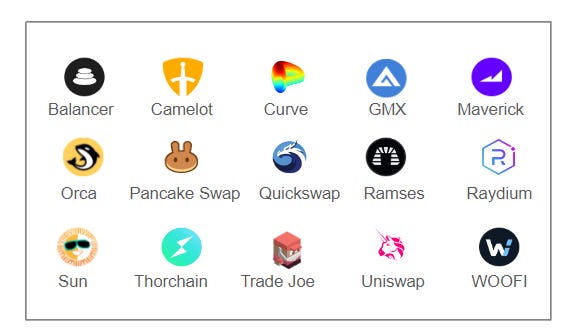Decentralized exchanges (DEXs) have established themselves as a cornerstone to the DeFi markets by offering an alternative way to trade digital assets without using centralized exchanges (CEXs) like Coinbase and Binance. In addition to their lower custodial risks and transparent execution as compared to CEXs, DEXs are also much easier to evaluate via onchain metrics such as the total value locked (TVL), verifiable trade volumes, and the number of onchain users. The key performance indicators and metrics that are used to evaluate the strength and health of a DeFi protocol are all transparent and stored on the blockchain it runs on. As the digital asset markets mature and attract more sophisticated investors, these real-time metrics will be frequently used to conduct fundamental analyses and create investment theses.
To assess the dozens of DEXes now operating, we’ve created a comparative scorecard analysis based on the following metrics: volume, valuation, and community. These three categories help evaluate the overall
health of the selected DEXs based on a mix of on-chain and off-chain metrics. The selected DEXs were chosen based on the amount of overall volume (data sourced from DefiLlama) and the existence of a corresponding token for the exchange.
Volume Metrics
See Legend below.
Uniswap leads the selected DEXs by weekly trading volume with $22.3b, making up almost ~20% of the total weekly DEX volume. As the first major AMM-style DEX, Uniswap maintains a significant first-move advantage and a larger TVL than the next 3 largest DEXs combined. DEXs within the Solana ecosystem, led by Orca and Raydium, have also seen significant weekly volume growth as the entire Solana ecosystem has gained market share in response to the rising gas cost on incumbent chains like Ethereum. Additionally, the vibrant memecoin ecosystem that has grown within Solana has been a significant contributor to Solana DEXs - notably, the top 10 assets by trade volume include such animal-based memecoins as dogwifhat, Popcat, and Solana.
Below is a comparison of the Volume / TVL ratio, which represents the capital efficiency of the DEX and how much trade volume it generates relative to its asset base (the liquidity pools for each trading pair). The protocols that operate in lower-fee environments (like Arbitrum and Solana) have higher Volume / TVL ratios, in part because it is more feasible for retail and other small traders to transact in lower ticket sizes that would be cost-prohibitive on Ethereum. Also, while it is often difficult to identify, it is also more likely to see wash-trading volume on lower-fee chains since the cost to spoof transactions is lower.
See Legend below.
Valuation Metrics
Like in other valuation techniques, comparing the relationship between market value and fundamental drivers are a useful way to gauge how the market is valuing DEXs. The Market Cap / Fees ratio compares the annualized amount of fees earned by a given DEX to its token’s market cap, to obtain a metric that is similar to the well-known Price / Sales ratio in the equities world. The Market Cap / Total Value Locked ratio compares the DEX token market cap to the amount of capital locked within the smart contract for the DEX. Total Value Locked (TVL) is a useful indicator of the overall health of the DEX; as the TVL increases, the liquidity of the DEX protocol also increases.
In the analysis, DEXs like WOOFI and Maverick are trading at a higher level in relation to the rest of the comparable set; however, the market caps of both these protocols are fairly small, and it might be an indication that the DEXs are overvalued. The analysis also illustrates that DEXs that operate on Solana like Raydium and Orca might be undervalued relative to the amount of fees they are generating on the network.
Source: Defillama as of 3/7/24
*Assuming 0.3% fee based on source
**Assuming 0.3% fee based on source
See Legend below.
Community Metrics
To get a sense of the type of user and community members utilizing each DEX, we compare metrics that involve the amount of visitors on the DEX’s website and both the volume and market capitalization of the DEX. These metrics help illustrate how easy each project can retain its users and capital on its network.
Thorchain and Curve have the highest community metrics in the comparable set, while projects like Raydium are on the lower end. If we look at the type of activity that occurs within each DEX, these metrics are not surprising. The community on Thorchain and Curve are strong and more sticky since both protocols offer sophisticated Defi trading strategies and mechanisms. However, DEXs like Raydium usually attract retail traders in the Solana ecosystem that are more known for trading meme coins and utilizing less sophisticated strategies. While both business models can be lucrative, DEXs that can garner better community metrics usually have larger life time value of their customers and possess more resiliency in market downturns and bear markets.
See Legend below.
Scorecard
By utilizing the three aspects of volume, valuation, and community within our qualitative scorecard, we can paint a picture of the overall DEX landscape and how each project compares to one another. While some strong projects including Uniswap and Thorchain have great volume and community metrics, the market takes these factors into account and forces them to trade at a premium, making their valuation less compelling and bringing their overall score down. Other projects like Ramses seem to have the opposite situation where the amount of market share they have is small, but the growth and value of the DEX is more attractive compared to others in the peer set.
According to the analysis, the Sun DEX and Uniswap have the highest score in the group, but this is mostly due to their first-mover advantage within their own respective blockchain ecosystems (Tron and Ethereum). Additionally, Thorchain and Orca both have high scores in the analysis, which is reasonable since they have been all growing and creating positive brand value in recent weeks.
This scorecard framework can be used as a tool to take into consideration both on-chain metrics like fees and TVL, along with off-chain metrics like website visitors and market capitalization. This analysis is most useful when monitored over time to see how each DEX can gain market share, and how the market prices these movements into its token valuations.
See Legend below.
The amount of spot volume traded on DEXs compared to centralized exchanges (CEXs) have been steadily increasing in the past few years as new platforms and protocols have become available for individuals to use. Activity on DEXs increased tremendously after the FTX crash, as investor sentiment towards CEXs began to deteriorate and the need for more transparent solutions became apparent. As we enter a new bull market, it will be interesting to monitor how new retail investors and institutions will decide whether to rely on CEXs for a better user experience, or utilize DEXs due to their more transparent and secure nature.
Conclusion
The ability to enable transparency and real-time stats of the financial health for exchanges is a revolutionary accomplishment that often goes overlooked. Only a few years ago did one of the biggest central exchanges (FTX) go bankrupt due to their illegal business practices and misuse of customer funds. The shift to analysis of on-chain metrics like revenue and assets within the protocol will spark a new paradigm in how businesses communicate with investors and the rest of the market. However, these on-chain metrics must be taken with a grain of salt since the data infrastructure and analytic tools are still being developed within the space. Additionally, as described here, protocols are beginning to realize that investors are utilizing these on-chain metrics to inform their investing decisions, so a more general high-level analysis like the scorecard is more valuable than relying on just one on-chain metric.
Legend
DISCLAIMER
This is for informational use only. This is not investment advice. Other than disclosures relating to Alpha Transform Holdings (ATH) and Alpha Sigma Capital (ASC) this information is based on current public information that we consider reliable, but we do not represent it as accurate or complete, and it should not be relied on as such. The information, opinions, estimates, and forecasts contained herein are as of the date hereof and are subject to change without prior notification. We seek to update our information as appropriate.
Any forecasts contained herein are for illustrative purposes only and are not to be relied upon as advice or interpreted as a recommendation. The price of crypto assets may rise or fall because of changes in the broad market or changes in a company's financial condition, sometimes rapidly or unpredictably. Past performance is not a guide to future performance, future returns are not guaranteed, and a loss of original capital may occur. Fluctuations in exchange rates could have adverse effects on the value or price of, or income derived from certain investments. We and our affiliates, officers, directors, and employees, excluding equity and credit analysts, will from time to time have long or short positions in, act as principal in, and buy or sell, the securities or derivatives, if any, referred to in this press release.
The information on which the information is based has been obtained from sources believed to be reliable such as, for example, the company’s financial statements filed with a regulator, the company website, the company white paper, pitchbook, and any other sources. While Alpha Sigma Capital has obtained data, statistics, and information from sources it believes to be reliable, Alpha Sigma Capital does not perform an audit or seek independent verification of any of the data, statistics, and information it receives.
Unless otherwise provided in a separate agreement, Alpha Sigma Capital does not represent that the contents meet all of the presentation and/or disclosure standards applicable in the jurisdiction the recipient is located. Alpha Sigma Capital and its officers, directors, and employees shall not be responsible or liable for any trading decisions, damages, or other losses resulting from, or related to, the information, data, analyses, or opinions within the report.
Crypto and/or digital currencies involve substantial risk, are speculative in nature, and may not perform as expected. Many digital currency platforms are not subject to regulatory supervision, unlike regulated exchanges. Some platforms may commingle customer assets in shared accounts and provide inadequate custody, which may affect whether or how investors can withdraw their currency and/or subject them to money laundering. Digital currencies may be vulnerable to hacks and cyber fraud as well as significant volatility and price swings.















